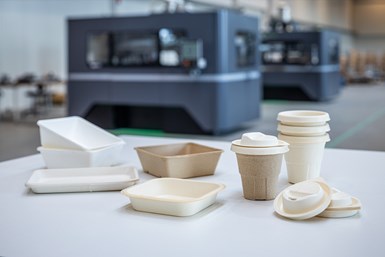ExOne Launches X1 Tooling Industrial-Grade 3D Printed Tooling Solutions
X1 Tooling offers manufacturers fast, affordable and local tooling options for the final production of metal, plastic and composite designs.
Share
Read Next

X1 MetalTool was used to produce tooling for Sweden-based Celwise’s molded fiber products.
The ExOne Co., a global provider of industrial sand and metal 3D printers using binder jetting technology, is launching X1 Tooling, a broad portfolio of industrial-grade 3D printed tooling that includes new solutions for plastic injection molding or forming, laying up composites, casting metals, and more.
The X1 Tooling line is designed to offer tooling options that speed up delivery times and bring tooling closer to the point of final production. Users that 3D print their tooling can help eliminate supply chain issues and make themselves more sustainable, with less shipping and other forms of waste. This fast, flexible tooling portfolio includes six new, affordable tooling applications, the company says.
For plastic production, X1 offers two options: X1 MetalTool is a new 3D printed metal tooling option which has passed preliminary tests to replace standard steel or aluminum tooling for plastic injection molding, blow molding and other plastic forming applications. It is available in 420i (said to be a highly durable and affordable steel-bronze matrix), as well as 316L stainless steel, M2 tool steel and more. This tooling can be finish machined, acid etched and polished to a diamond finish, and is well suited for complex inserts. The second option is X1 ThermoForm which involves a 3D printed sand form infiltrated with a durable resin and coated to create small- to large-format molds for a variety of thermoforming applications, such as vacuum forming, compression molds, foam molding and more.
For composite production, X1 offers X1 Layup and X1 Washout. X1 Layup involves a 3D printed sand form infiltrated with a durable resin and coated for high-precision, high-temperature composite layup applications. It offers dimensional tolerances of ±0.025" and the tooling can be precision machined if needed. X1 Washout is a 3D printed sacrificial tooling that washes out with tap water after traditional layup and autoclaving of composite materials, including carbon fiber. It is a sand form 3D printed with a water-soluble binder and surface coated. It is well suited for ducting, mandrels and other designs with trapped geometries.
For metal production, X1 offers three options: X1 SandCast delivers sand tooling in a variety of sand types and binders, including sustainable inorganic formulas for high-quality aluminum castings. X1 MetalTool, a tool for plastic forming applications, can also be used to directly 3D print end-of-arm tooling, and rugged, perishable or consumable tools in a variety of metals, including tool steels. While still in development, X1 DieMold is used in rugged die molds 3D printed in H13 tool steel and is currently being fast-tracked with several global manufacturers after passing proof-of-concept tests.
All sand- and sand-infiltrated tools are produced using ExOne S-Max series printers with build volume measuring 1,800 × 1,000 × 700 mm (70.9" × 39.4" × 9.84"). X1 MetalTool and X1 DieMold tools are 3D printed in an X1 25Pro with build volume of 400 × 250 × 250 mm (15.75" × 9.84" × 9.84"); development is underway for printing in the larger X1 160Pro.
Related Content
DMG MORI: Build Plate “Pucks” Cut Postprocessing Time by 80%
For spinal implants and other small 3D printed parts made through laser powder bed fusion, separate clampable units resting within the build plate provide for easy transfer to a CNC lathe.
Read MoreAt General Atomics, Do Unmanned Aerial Systems Reveal the Future of Aircraft Manufacturing?
The maker of the Predator and SkyGuardian remote aircraft can implement additive manufacturing more rapidly and widely than the makers of other types of planes. The role of 3D printing in current and future UAS components hints at how far AM can go to save cost and time in aircraft production and design.
Read MoreAluminum Gets Its Own Additive Manufacturing Process
Alloy Enterprises’ selective diffusion bonding process is specifically designed for high throughput production of aluminum parts, enabling additive manufacturing to compete with casting.
Read MoreMultimaterial 3D Printing Enables Solid State Batteries
By combining different 3D printing processes and materials in a single layer, Sakuu’s Kavian platform can produce batteries for electric vehicles and other applications with twice the energy density and greater safety than traditional lithium-ion solutions.
Read MoreRead Next
At General Atomics, Do Unmanned Aerial Systems Reveal the Future of Aircraft Manufacturing?
The maker of the Predator and SkyGuardian remote aircraft can implement additive manufacturing more rapidly and widely than the makers of other types of planes. The role of 3D printing in current and future UAS components hints at how far AM can go to save cost and time in aircraft production and design.
Read MoreHybrid Additive Manufacturing Machine Tools Continue to Make Gains (Includes Video)
The hybrid machine tool is an idea that continues to advance. Two important developments of recent years expand the possibilities for this platform.
Read More4 Ways the Education and Training Challenge Is Different for Additive Manufacturing
The advance of additive manufacturing means we need more professionals educated in AM technology.
Read More








.png;maxWidth=300;quality=90)













